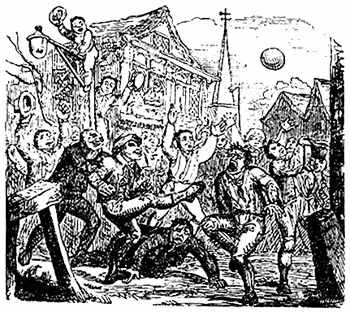
Modern football is a sport that anyone who has played or watched it will know and understand. Two teams with 11 players on each go up against each in order to score more goals than the other side, therefore being declared the winner.
Most people who have more than a passing interest in the sport will know about its origins, how it developed and became the sport that it is today. If you’re not one of those people then fear not, you can read about it elsewhere on this site.
What a lot of people might not know all that much about is the sport of folk football, which was popular during medieval times and lent some of its rules to the game that eventually became association football. It was a far more violent game than football today, more akin to rugby in many respects.
Indeed, the fact that the games were also known as ‘mob football’ probably gives you a fair chunk of information regarding how they were played. There were fewer rules than the modern version of the sport, being far more chaotic and wild.
The Sport’s Origins
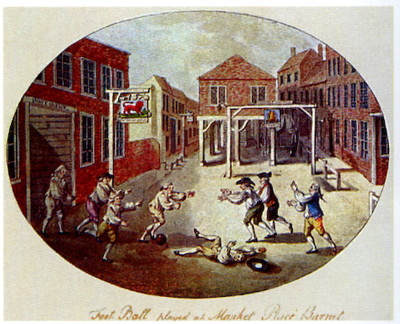
The first reference to a sport involving the use of the ball in post-classical Europe was written in Wales in a text entitled Historia Brittonum, supposedly by a monk called Nennius. It includes a reference to boys ‘playing at ball’, but doesn’t give much more information than that.
Yet the sport that we’re looking at here was commonly played on Shrove Tuesday. Each set of school students would have their own ball, as would workers from the various crafts. They would all head into the field in order to kick the ball about, watched over by their elders.
The game developed in the years that followed, eventually leading to King Edward III banning the version of the game that was popular in 1363 when he declared,
“[m]oreover we ordain that you prohibit under penalty of imprisonment all and sundry from such stone, wood and iron throwing; handball, football, or hockey; coursing and cock-fighting, or other such idle games”.
It remained officially banned until 1667. Not that that stopped people playing it, of course. It’s just that they did so knowing that their punishment for doing it could be imprisonment.
How Folk Football Worked
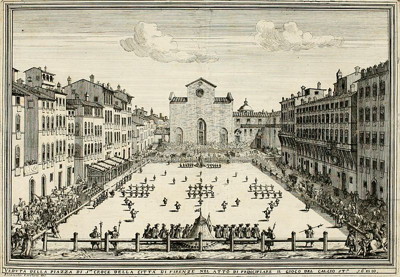
The game of folk football that began to develop out of the ball games that were played in England from as early as the 14th century had few rules and involved large numbers of people. They would often be from different villages or else a single village’s occupants would be split into two teams according to where they were based. Oftentimes these games were linked to important dates, which is where the idea of football games on Shrove Tuesday came from. The following line of poetry applies to it:
“When the pancakes are sated, Come to the ring and you’ll be mated, There this ball will be upcast, May this game be better than the last”
The distance between ‘goals’ could be as far as two or three miles, with the house that the captain of each team lived in often used for this purpose. Accounts of games would read rather like reports on modern day rugby matches, complete with the sensation of every step being keenly fought over and men putting their bodies on the line to win the contest.
King James First was a firm believer in the importance of sport, but he forbade his son Henry from taking part in folk football because it was seen as being too violent. It was described as a ‘bloody and murthering practice, rather than a fellowly sport or pastime’, with no rules in place to prevent players from tripping or hacking members of the opposition. It was not unusual for limbs to be broken, fights to break out and even deaths to occur during the most violent folk football matches.
Modern Day Folk Football
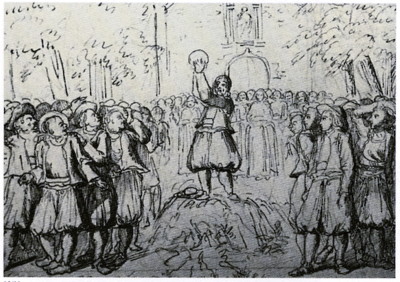
Whilst the modern day variation of the game certainly lacks the overt violence of the more ancient variation of the game, it does still take place in different towns and villages across the United Kingdom. In fact, the sport has seen something of a revival since the latter part of the twentieth century. Despite the royal proclamations making it illegal and the fact that the more law-abiding citizens have long taken against it, folk football has survived all attempts to kill it off.
One example can be found in the village of Kirkwall in Orkney, where players take to the streets on the first of January every year at exactly ten in the morning in order to play their own version of the game. At Workington in Cumbria there is a Hocktide game, which is played on the first Sunday after Easter. Duns in the Scottish Borders plays witness to folk football games in July during Relvers Week, when single men and married men go up against each other.
In Ashbourne the game has survived virtually non-stop, with many locals claiming that the tradition dates back to the 12th century. That’s difficult to confirm, but many thought that the traditional had run its course when someone was drowned as part of a folk football game in 1878. The police attempted to stop it being played in the future but that only led to violent clashes, with many feeling that the organised opposition only served to ‘breathe new life’ into it as a sport.
Such is the nature of the game at Ashbourne that it has become something of a tourist attraction. It doesn’t quite boast the violent reputation of the variant of the sport played in Workington, which is the largest British town to still be playing folk football. There are also variations of the same theme played in different villages that actually don’t even use a ball, including one in the Lincolnshire village of Haxey Hood where teams attempt to get a tube containing some rope into the pub of their choice.
The Lead-In To The Modern Game
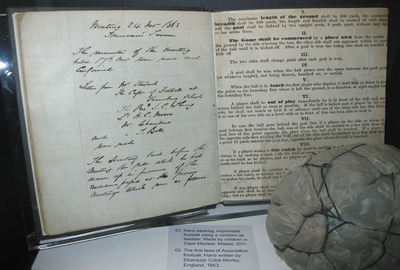
Whilst the link between the game of football that we know today and that of folk football is tangential at best, it is still there. Kicking was allowed during folk football, for example, but it was mainly the kicking of other players rather than the ball. In fact, the ball used was often so large and heavy that kicking it would have been virtually impossible. It’s noteworthy, however, that the size and weight of the ball used in the modern game of football wasn’t actually decided upon until nine years after the 1863 rules had been established.
A game between London and Sheffield in 1866 saw the two teams decide upon a mutually acceptable ball size, though the match itself was more noteworthy for being the first to be played over 90 minutes. It was closer in line with the modern version of the sport than the folk football games insomuch as it required a specific number of players on each team. Folk football, on the other hand, was open to an unlimited number of players and offered no rules for the players to follow.
The other major link between the two versions of a game bearing the name ‘football’ is its presence in Britain. Whilst sports involving balls were played all around the world, the evolution of football into the game that it is today is widely accepted as taking place in Britain. Over a period of around one thousand years, the game has developed from being a free-for-all that involves as many people as want to play to being a far more structured and specific game with so many rules that some supporters don’t even know them all.
